From Industrialization to the Information Age
Anthias (2007) and Griffith (1998) argue that, post-industrialization marks the transition where service sector offers more revenue than the manufacturing sector in specific nations. In the 19th century during the industrial age, Britain was the leading nation in industrialization. Britain had founded its empire on the mercantilism era where it emphasized on in-side trading and suppressed any rival empires.
The mercantile economic theory was founded on the principle of ensuring collaboration between the merchants and the Britain in order to enhance private wealth and political power by segregation of other empires. In order to enforce the mercantile theory, the British government sheltered its merchants and segregated others through regulations, trade barriers, and subsidiaries of local industries. These measures favoured local industries and suppressed foreign industries.
However, as time elapsed there was a need to collaborate in trading. The emergence and propagation of globalization favoured other nations that were more recipient to the changing economic evolvement. Nations such as Germany, United States and Japan overtook Britain in the international trading.
This happened during the Fordism period where many industries evolved from large static organisations with stable markets to small dynamic firms with specialized markets. The shift-attracted mass production and economy of scale became the competing factor.
According to Held (1999) and Herman (1999), the continuous proliferations of globalization lead to an increased competition because of consumers’ access of many varieties of products/services. Of late, there has been a great evolvement of the trade policy pursued by the EU.
The EU has continuous loosened their tight regulations by tariffs and quotas to embrace non-tariffs barriers to trade, as well as single market. The EU trading policy are known for being committed towards specific policy issues that entail gender relations, social policy, labour protection and environmental sustainability that greatly curtail free trade international.
The demand for high quality, low costs and shorter period for production because of globalization and market liberalization has called for outsourcing of some services as well as high participation of women in the labour market.
Whereas Herman (1997) associate American firms in opting for outsourcing most of their services in response to the current stiff global competition, Hurrell (2000) argue that firms in Europe and particularly the UK respond by attracting young and educated personnel from foreign countries to come and boost their slow economy.
The Europe economy is slow because of low birth rate associated with high level of older working population, which is too slow to support the inactive group. Nonetheless, there has been great trade integration worldwide despite the EU reluctant participation (See appendix 15)
Identifying and discussing features of UK economy and how structural changes have affected the labour market and HR policies
According to Boeri & Ours (2008) and Kahanec & Zimmermann (2010), UK has experienced economic and labour market changes in the recent past. As at 2011, the country had a nominal GDP of $2.480 trillion and a GDP average growth of 0.6%. Various features signify this economy.
These range from labour markets to trade among other prominent factors. From this context, it is evident that the country has endeavoured to expand her economic prowess through numerous means. The country’s economy is built massively by the service sectors, trade, agriculture, industry, and minimized mining activities. Labour market provision forms a critical component of the economic growth.
The economy experienced an inflation of nearly 3.5% with unemployment rate of approximately 8.2% as at 2011 (OECD 2011; appendix 1). This trend is inconsiderable to the labour market. Since economy builds largely on the service sector, it is apparent that structural changes in the economy and other sectors have immensely affected the labour market, HR policies, and other practices within organisations.
Considerably, labour market forms a critical provision in the UK’s economy as indicated earlier. Due to numerous structures that define economy, labour markets have experienced tremendous reforms in the realms of policies, equality, and other probable features. Currently, UK’s labour force consists of reasonable number of females compared to the past records (See appendix 3).
The establishment and ratification of Single Equalities Act (2010) has helped in promoting fairness in the labour markets belonging to various sectors of the economy (Great Britain 2010). The aspects of race, gender, and culture are no longer significant threats in the labour markets. Evidently, the need to incorporate equality in the building of the UK’s economy has necessitated the restructuring of the human capitals and reformation of the HR policies applicable in numerous organizations within the territory.
This is a prominent phenomenon when considered critically. There have been considerable economic and labour market changes and developments in the recent past. These followed the economic downturn that affected the country recently. Nonetheless, UK is restructuring its labour market provisions and providing equitable working provisions in most of its economic sectors.
Most organizations have restructured their labour policies to enact the aspects of equality and eliminate prejudicial acts that have affected the UK’s labour markets as indicated before (Prasad 2002). Observing the aspects of equality, reasonable pay, preferable working conditions, and other prominent factors have contributed massively to this aspect.
UK sluggish economic growth since 2008’s recession-Organisations and HR functions
The economic recession that engulfed UK since 2008 is evident in the realms of its impacts and aftermath events. The recovery has been slow as evident by the 0.6% average GDP growth in 2011. Nonetheless, most organizations in the region have endeavoured to restructure their operational mechanisms in order to address the situation.
Evidently, recession is characterized by high values of unemployment rates, inflation in the prices of products, reduced productivity, and other economic variables relevant in this context. To address the aspects of employment in the region during the recessional period, organizations resolved to augment employment opportunities and other provisions that could create equality and enhanced chances for numerous people
in the job market (Kew&Stredwick 2010). Restoring the aspects of employment is one of the ways through which a country can respond to its economic downturn and other characterizing features. In order to increase the income of majorities during the mentioned recession, concerned organizations strived to address other prominent economic factors.
Creating equitable employment provision in the labour market mattered massively (Prasad 2002). From this context, the aspects of gender, race, and other factors were considered by numerous organizations in order to eliminate inequalities in the labour market.
The HR sectors have managed to set the minimum wages for employees in order to standardize their earnings to the global gauges. Providing considerable working conditions, diversifying numerous labour sectors to accommodate more employees, adopting the policies set to enhance equality within the workforce, and embracement of best practices in the labour market are some of the moves that the concerned HR sectors and organizations have managed to enact (International Labour Office 2011).
These help in realizing remarkable changes and curbing the recent recession noticed within the country. From this context, it is evident that numerous sectors within the country have managed to help in the restoration of the economy and reestablishment of HR functions in order to meet various labour market demands globally (Smith 2003).
Sourcing for appropriate, competent, and capable employees regardless of their sex, race, religion, and other factors are other contributory factors in this context. Expertise in the workforce helps massively in enhancing the economy of the state. The responses given by organizations and HR functions in response to the situation have been considerable in various situations (Sachs 2004)
Identifying if economic circumstances since 2008 have had a detrimental and disproportionate impact on any particular groups of workers and jobseekers
Evidently, the economic hitches since 2008 have had a detrimental and uneven impacts on the female workers, other racial groups, minority groups, and jobseekers in the labour market within UK and beyond (Goos& Manning 2007). The noticed economic hitches interfered with the job opportunities since most businesses halted their operations and the few ones, which were operating, registered minimal production rates. Eventually, they reduced their recruitment processes and the resultant employee intakes.
This reduced employment rates considerably leading to the witnessed unemployment hitches. Nonetheless, the condition has restored considerably compared to the past. Precisely, the witnessed economic hitches affected the job market remarkably (Shimer 2010). The rate of jobseekers increased tremendously and the issues of inequality increased in order to favour particular groupings in the labour market. This is a prominent consideration in various contexts.
It is agreeable that recession have devastating impacts on the labour market. It distorts employment opportunities and renders the job market miserable especially to job seekers and contracted workers. In the contexts of gender inequality, unemployment created by recession can affect the vulnerable groups considerably.
Studies shows the percentage employed, unemployed and inactive for the ethnic minority groups. The lowest percentages of employment were for the Bangladeshi and Pakistani groups, being 43% and 46% respectively. Indian group had the highest percentage employed at 70.9%.For the Bangladeshi ethnic group the percentage inactive stood at 44.5% and for the Pakistani group 43%.
The reason for inactive in these groups was to look after family (appendix 1). The UK indicate a biased pay rates and level of employment for diversified groups with the whites being the most favoured grouop in employment and payment rates as indicated by table 12.
From the studies, it is evident that the UK’s workforce has incorporated the aspects of equality in various ways. The number of women plunging into the labour market is increasing tremendously compared to the previous years (appendix 3). This is a lucrative observation with regard to how the recent economic challenges have affected the concerned vulnerable groups. Precisely, the reduction of job opportunities has been detrimental to the entire scenario in the realms of labour market development.
Notably, the levels of employment have increased among women with the annual growth remaining considerable. Consequently, it is appropriate that inequality within the labour market is decreasing tremendously. This is an important provision in the economic growth of UK and beyond.
The country endeavours to eradicate the aspects of inequality by enacting Single Equalities Act, which demands equitable distribution of opportunities regardless of the gender, age, race, religion, or other prejudicial factors that might limit the prosperity of the nation (Irvin 2008). The findings from the study indicate that there is a massive increase employment opportunities for the marginalized groups and the aspects of inequality are diminishing remarkably.
Technological changes and globalisation play some important role in driving income inequality. Technological change has participated to a rise in income inequality among full-time workers.
The impact on inequality reproduce that the technological change reduces the demand for medium-skilled workers who carry out routine tasks that can also be accomplished by computers, while increasing the demand for low and high skilled workers who tend to focus on respectively abstract and manual non-routine tasks that are harder to replace by machine. European economies show that the income inequality trend continues. In UK, there is a positive average inequality of 0.37 as reflected in appendix 9.
Rodrik (1997) and Rosenau (2002) posit that globalisation may also widen the dispersion of labour income, for example through, greater outsourcing of tasks from richer to poorer countries. The UK has a greater economic growth and lower unemployment rate than other Europeans countries as shown in appendices 13 and 14.
Therefore, globalization and liberalization of trade should facilitate greater integration of trade among the EU member states. However, the great labour market regulations exerted by the UK does not allow free labour market. Thus, greater regulation in employment opportunities against other EU members from the perspective of the poorer countries, labour demand will become more skill intensive in both poorer and richer countries, thus increasing inequality in both groups of countries.
London Economy and Labour Market (Extent of Inequality and Its Disadvantages within the Region)
London is one of the massive business centres globally. It has a substantial economy with diverse labour markets meant to enhance its economic growth as seen in appendix 2. Its economy thrives among the largest ones in the world including New York City and Tokyo among others.
Its economy grows through service industries, transport ventures, manufacturing, and construction endeavours. The levels of employment opportunities are reasonable in the city despite the challenges. Considerably, the number of women in the job market with regard to this city is less compared to men (charter 3, appendix). However, the numbers are growing tremendously on a daily basis. The city has one of the thriving economies globally as mentioned earlier.
The needs to augment this provision to escalated levels have necessitated the creation of various job opportunities to help in curbing the labour market challenges. The key features of the economy are that it is supported credibly by the service sectors besides other economic activities within the city.
Kapstein (1999) posit that globalization should ensure a cross-border sharing of labour. However, Edwards & Wajcman (2005) claim that the issue of ethnic diversity is evident in London. This is a notable provision in the workforce eliciting some prejudicial moves and other discriminative provisions in the labour market.
The labour market of London varies considerably in numerous provisions. Evidently, generation Y (employees born as from 1980s) have flocked the labour market compared to those above the age of 50s as seen in appendix 10. This means that the London’s labour market has energetic, strong willed, innovative, and dynamic employees who have induced the aspects of change within the labour market and beyond.
Nonetheless, London has a high level of unemployed young people of 23% in comparison to 18% in the rest of UK as reflected in appendices 7 and 8. Unemployment of young people in EU and particularly in UK has persisted as reflected in appendix 11.The aspects of inequality within the workplace are evident; nonetheless, the rate is considerably reducing having enacted various laws to govern HR functions and operations of numerous organizations within the territory.
While still considering the labour market features, the London’s labour market has considerable number of women compared to earlier years (Mazumdar&Sarkar 2008). Additionally, the city has both a highly skilled and highly paid workforce compared to other cities in the country.
It has also attracted some of the highly qualified workforce from various parts of the world. This renders the services provided in this city quite competitive compared to others in the similar category. It is also evident that the aspect of pay varies considerably within the city. There is no equality in the remuneration; nonetheless, this depends on the kind of job that one does and the level of expertise offered. Various industries differ remarkably on the kind of pay they offer to the labour market (Table 4, appendix).
The aspects of inequality are considerable in London. Gender, race (Bama or non-Whites), disabled, expertise, and other factors have exhibited higher levels of inequality (Kahanec& Zimmermann 2010). See appendix 10.Although women had limited chances in the labour markets as demonstrated previously, the trend is continuously changing. Inequality is devastating in various contexts. It deprives honest people their opportunities.
Additionally, it reduces the economic growth of the city and UK at large since potential people in the labour market might be locked out. It equally hinders the aspects of talents and other prominent provisions in this context. Britain is experiencing a high inequality between the rich and the poor.
Causes of Inequality and Disadvantages-Impact of Equality Act (2010)
Causes of inequalities are numerous as evident from numerous contexts. Firstly, one’s starting point in life might favour him or her ahead of others. People born in families with various opportunities and networks will hardly compete favourably with others. Another aspect is the constitution. If the law gives room for inequality to reign, most people will not bother to eradicate the vice.
This has forced UK to enact the Equality Act (2010) to help in fighting the vice. It is through policies that the mentioned inequality can be eliminated within the country. National economy equally contributes to the aspects of inequality. If the economy is wrecked, most people will mind their own affairs thus denying others opportunity to survive in the similar situation. Since economic meltdown creates uncertainties, it eliminates the aspects of trust and other conventional provisions.
Other causes include global influence, tax and policy among others. Disadvantages of inequality are numerous and devastating. As indicated before, inequality denies competent people opportunities they deserve. It eventually affects the economic growth of the country and wastes human resources. Potentially, Equality Act (2010) will eradicated inequality and ensures equal opportunities in the labour market and in the workplace (Great Britain 2010; Oman 2000,).
Key future developments in the London’s economy and labour market (up to 2016) and what the implications of these could be for national and regional policy makers
According to Stallings (2001) and Strange (2002), the London’s future economy and labour market will increase considerable come 2016. Despite the current economic hitches, the city is opening up its operations, employment opportunities and eradicating inequality, which has been a massive hindrance to the growth of the city.
This is an evident phenomenon when scrutinized critically. It is from this context that various aspects the labour market and economic prospects rest. Introduction of various services within the city and being an international business hub is a critical provision that will help in propelling the city tremendously. With the establishment and ratification of Equality Act (2010), the city’s labour market will increase considerably.
Competent employees will cease various opportunities within the city come 2016. Additionally, prejudicial acts in the workplace and labour market will eventually reduce remarkably. Since London provides the highest job opportunities and even pays within UK, the trend is predictable to continue for decades to come.
Employees in London receive higher remuneration rates compared to other cities in the same territory. Precisely, London has a bright future in the realms of economic enhancement and labour market prowess come 2016. This is supported by its status in the world and the opportunities it offers to masses globally.
A Conclusion Built on Responses and Highlights
Organizations located in London and other various parts of UK should embrace equality and harness the rich labour market that the region contains. This is only possible if the aspects of inequality are eradicated. Additionally, this will help in boosting the economy of the city tremendously (Boeri & Ours 2008). HR departments should establish integrity within their endeavours by avoiding the acts of inequality and provide opportunity based on merit and not any other prejudicial factors.
The future developments of London require considerable organizations and HR departments, which can propel the city into a bright future. The concerned stakeholders must have specialised knowledge, relevant skills/competencies, and other constructive qualifications.
List of References
Anthias, F. (2007) Ethnic ties: social capital and the question of mobility, The British Journal of Sociology, 55(4), pp.787-805 [Online] Wiley Online Library.
Boeri, T & Ours, J 2008, The economics of imperfect labor markets, Princeton Univ. Press, Oxford.
Edwards, P &Wajcman, J 2005, The Politics of Working Life, Oxford University Press, Oxford, UK.
Griffith, J 1998, Global Capital Flows, London, Macmillan.
Goos, M & Manning, A 2007, ‘Lousy and lovely jobs: the rising polarisation of work in Britain’, Review of Economics and Statistics, Vol. 89, no. 1, pp. 118-133.
Great Britain 2010, Equality Act 2010, Part 15, The Stationery Office, London, UK.
International Labour Office 2011, Strategy for gender mainstreaming in the Employment Sector, 2010-2015: aligned with ILO action plan for gender equality, 2010-2015, Phase I: Programme and Budget, 2010-2011, ILO Press, Geneva, Switzerland.
Held, D 1999, Global Transformation: Politics, Economics, and Culture, Stanford, Stanford University Press.
Herman, B 1999, Global Financial Turmoil and Reform: A United Nations Perspective, Tokyo, United Nations University Press.
Herman, E 1997, The Global Media: The New Missionaries of Corporate Capitalism, London, Cassell.
Hurrell, A 2000, Inequality, Globalization, and World Politics, Oxford, Oxford University Press.
Irvin, G 2008, Super rich: The rise of inequality in Britain and the United States, Polity Press, Cambridge.
Kahanec, M & Zimmermann, K 2010, EU labor markets after post-enlargement migration, Springer Verlag, Heidelberg, Germany.
Kapstein, E 1999, Sharing the Wealth: Workers and the World Economy, New York, Prentice Hall.
Kew, J &Stredwick, J 2010, HumanResource Management in a business context, CIPD, London, UK.
Lansley, S 2009, How Middle Income Britain’s Shrinking Wages Fueled the Crash and Threaten Recovery. [Online] Trade Union Congress.
Mazumdar, D &Sarkar, S 2008, Globalization, labor markets and inequality in India, Routledge, London, UK.
OECD 2011, England, United Kingdom, OECD, Paris, France.
Oman, C 2000, Globalisation and Regionalisation: The Challenge for Developing Countries, Paris, OECD Development Centre Prasad, E 2002, Wage inequality in the United Kingdom, 1975 – 99, IMF.
Shimer, R 2010, Labor markets and business cycles, Princeton Univ. Press.
Smith, D 2003, UK current economic policy, Heinemann Educational Books, Oxford, UK.Equalities Review 2007, Fairness and Freedom: The Final Report of the Equalities Review: Summary.
Appendices
Some Indicative Labour Market Statistics
Appendix 1
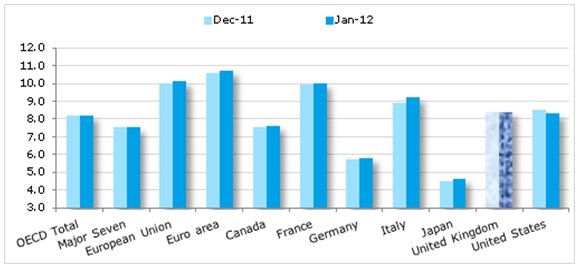
Selected Unemployment Rates, s.a.
December 2011 – January 2012 (1) United Kingdom: October 2011 – November 2011
Appendix 2
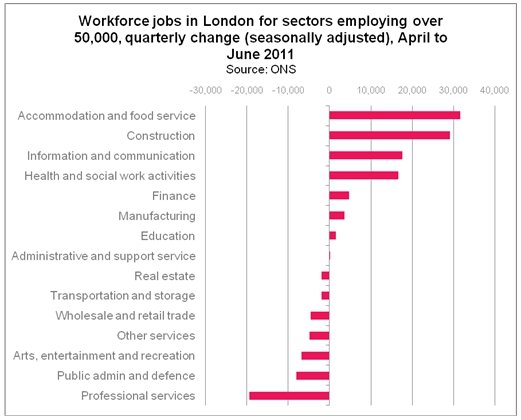
Graph 1: Graphical representation of males and females in the UK’s Job Market (1985-2008)
Appendix 3
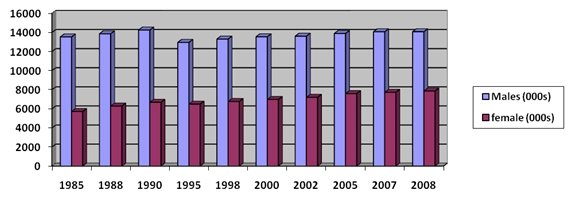
Appendix 4
Hourly Pay (Excluding Overtime) Selected Occupations April 2008
Appendix 5

Appendix 6
Table 12: Distribution of men and women by employment category, E.U. 11, 1990
Women in Job in UK: Source of information BBC News
Labour market-related activity of young people in london
Appendix 7
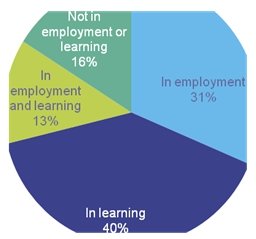
Appendix 8
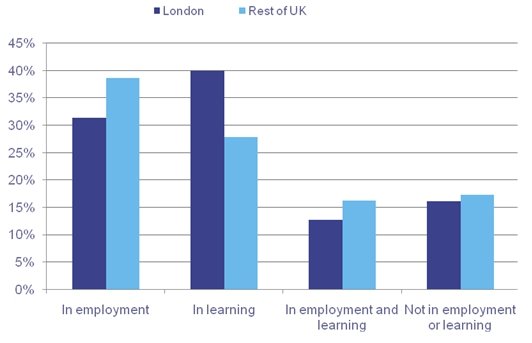
Appendix 9
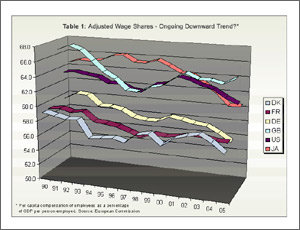
Wage inequality in UK labour market
Appendix 10
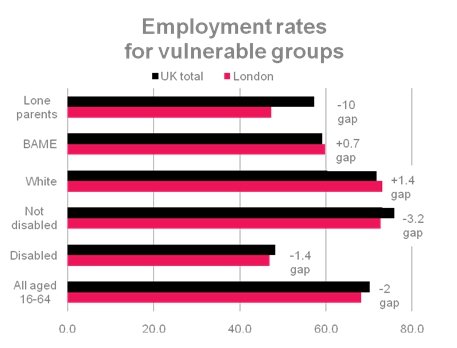
Appedix 11
Table 2: Youth Unemployment Rates (%) in the EU-15, 1986- 1998 (seasonally adjusted)
Appendix 12
Ethnic minorities in the UK labour market
Appendix 13
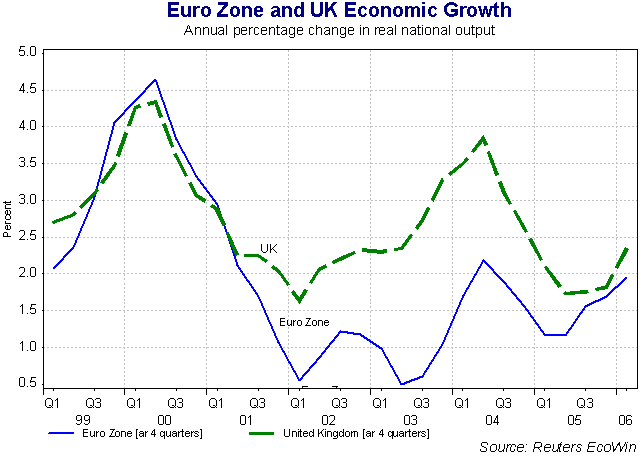
Appendix 14

Appendix 15
